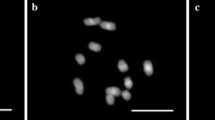Abstract
Cytological studies of hybrids between three chromosomal forms of the grasshopper, Caledia captiva, have revealed a clear case of pairing and exchange between non-homologous chromosomes. The genomes of each of the three chromosomal forms are readily identifiable by their marked differences in morphology and in the pattern of C-heterochromatin distribution. The testes of inter-racial F1 hybrid males contain both diploid and tetraploid meiocytes within the same individual. Multiple chromosome associations are a regular feature of all diploid cells. In many cases, these multiples involve two or more non-homologous chromosomes from within the same haploid genome. Such associations reveal unambiguous evidence of meiotic exchange and “chiasmata”. The X chromosome is frequently observed to associate with an autosome, and anaphase I cells provide evidence of X/autosome exchanges. A correlation exists between the position of the exchange event in non-homologous pairs and the location of heterochromatin. In tetraploid meiocytes, pairing is by strict homology only, giving rise to cells with 22 bivalents plus an XX bivalent or two univalent X chromosomes. Segregation patterns in tetraploid cells are entirely normal and result in the production of diploid gametes. In the male, the increased ploidy level was observed to arise following an endoreduplication process which takes place pre-meiotically in the spermatogonial cells. The finding that non-homologous chromosomes from within the same haploid genome can pair and cross over during meiosis clearly shows that some caution must be taken when interpreting multiple associations as evidence of interchange heterozygosity in hybrids.
Similar content being viewed by others
References
Alexander, D.E.: Spontaneous reciprocal translocation during megasporogenesis of Maize haploids. Nature (Lond.) 201, 737–738 (1964)
Callan, H.G., Spurway, H.: A study of meiosis in inter-racial hybrids of the newt, Triturus cristatus. J. Genet. 50, 235–249 (1951)
Catcheside, D.G.: The chromosomes of a new haploid Oenothera. Cytologia (Tokyo) 4, 68–113 (1932)
Darlington, C.D.: Recent advances in cytology, 2nd edit. London: Churchill, 1937
Ernst, H.: Zytogenetische Untersuchungen an haploiden pflanzen von Antirrhinum major L. Z. Bot. 35, 161–190 (1939)
Flavell, R.B., Bennett, M.D., Smith, J.B., Smith, D.B.: Genome size and the proportion of repeated nucleotide sequence DNA in plants. Biochem. Genet. 12, 257–269 (1974)
Gillies, C.B.: Ultrastructural analysis of maize pachytene karyotypes by three dimensional reconstruction of the synaptinemal complexes. Chromosoma (Berl.) 43, 145–176 (1973)
John, B., Henderson, S.A.: Asynapsis and polyploidy in Schistocerca paranensis. Chromosoma (Berl.) 13, 111–147 (1962)
John, B., Lewis, K.: The meiotic system. Protoplasmatologia VI F1. Wien-New York: Springer 1965
John, B., Lewis, K.: Genetic speciation in the grasshopper Eyprepocnemis plorans. Chromosoma (Berl.) 16, 308–344 (1965)
Kimber, G., Riley, R.: Haploid angiosperms. Bot. Rev. 29, 480–531 (1963)
Lantz, L.A., Callan, H.G.: Phenotypes and spermatogenesis of interspecific hybrids between Triturus cristatus and T. marmoratus. J. Genet. 52, 165–185 (1954)
Levan, A.: Studies on the meiotic mechanism of haploid Rye. Hereditas (Lund) 28, 177–210 (1942)
Majisu, B.N., Jones, J.K.: Aegilops × Secale hybrids: the production and cytology of diploid hybrids. Genet. Res. (Camb.) 17, 17–31 (1971)
Moran, C.: Population studies of the grasshopper Caledia captiva in South-east Queensland. Ph.D. thesis, Australian National University 1978
Moran, C., Shaw, D.D.: Population cytogenetics of the genus Caledia (Orthoptera: Acridinae). III. Chromosomal polymorphism, racial parapatry and introgression. Chromosoma (Berl.) 63, 181–204 (1977)
Müller, W.P.: Diplotene chromosomes of Xenopus hybrids oocytes. Chromosoma (Berl.) 59, 273–282 (1977)
Peacock, A.D., Harrison, J.W.: Hybridity, parthenogenesis and segregation. Nature (Lond.) 117, 378–379 (1926)
Rieger, R.: Inhomologenpaarung und meioseablauf die haploiden formen von Antirrhinum majus L. Chromosoma (Berl.) 9, 1–38 (1957)
Rieger, R., Michaelis, A., Green, M.M.: A glossary of genetics and cytogenetics, 3rd edit. Berlin-Heidelberg-New York: Springer 1968
Riley, R., Chapman, V.: Haploids and polyhaploids in Aegilops and Triticum. Heredity 11, 195–207 (1957)
Riley, R., Flavell, R.B.: A first view of the meiotic process. Phil. Trans. roy. Soc. Lond. B 277, 191–199 (1977)
Sadasivaiah, R.S., Kasha, K.J.: Meiosis in haploid barley: an interpretation of non-homologous chromosome associations. Chromosoma (Berl.) 35, 247–263 (1971)
Sen, S.K.: Synaptinemal complexes in haploid Petunia and Antirrhinum sp. Naturwissenschaffen 57, 550 (1970)
Shaw, D.D.: Population cytogenetics on the genus Caledia (Orthoptera:Acridinae) I. Inter and intraspecific karyotype diversity. Chromosoma (Berl.) 54, 221–243 (1976)
Shaw, D.D., Webb, G.C., Wilkinson, P.: Population cytogenetics of the genus Caledia (Orthoptera: Acridinae) II. Variation in the pattern of C-banding. Chromosoma (Berl.) 56, 169–190 (1976)
Spurway, H., Callan, H.G.: The vigour and male sterility of hybrids between the species Triturus vulgaris and T. helveticus. J. Genet. 57, 84–118 (1960)
Stebbins, G.L., Pun, F.T.: Artificial and natural hybrids in the Graminae tribe Hordeae. VI. Chromosome pairing in Secale cereale × Agropyron intermedium and the problem of genome homologies in the Triticinae. Genetics 38, 600–608 (1953)
Stern, H., Hotta, Y.: DNA synthesis in relation to chromosome pairing and chiasma formation. Genetics, Suppl. 61, 27–39 (1969)
Ting, Y.C.: Further studies of the synaptinemal complex of haploid Maize. Maize Genet. News Lett. 45, 11–12 (1971)
White, M.J.D.: Cytogenetics of the grasshopper Moraba scurra. I. Meiosis of interracial and interpopulation hybrids. Aust. J. Zool. 5, 285–304.
White, M.J.D.: The role of chromosomal translocations in Urodele evolution and speciation in the light of work on grasshoppers. Amer. Naturalist 95, 315–321 (1961)
White, M.J.D.: Animal cytology and evolution, 3rd edit. Cambridge-London: Cambridge University Press 1973
White, M.J.D., Contreras, N., Cheney, J., Webb, G.C.: Cytogenetics of the parthenogenetic grasshopper Warramaba (formerly Moraba) virgo and its bisexual relatives. II. Hybridisation studies. Chromosoma (Berl.) 61, 127–148 (1977)
Author information
Authors and Affiliations
Rights and permissions
About this article
Cite this article
Shaw, D.D., Wilkinson, P. “Homologies” between non-homologous chromosomes in the grasshopper Caledia captiva . Chromosoma 68, 241–259 (1978). https://doi.org/10.1007/BF00335419
Received:
Accepted:
Issue Date:
DOI: https://doi.org/10.1007/BF00335419




